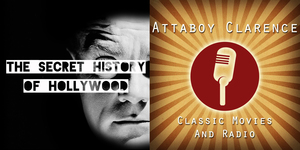A deft send-up of the Hollywood system, 'Stand-In' is a sparkling little comedy that pokes fun at, and warmly embraces the studio system of 1937, whilst providing an affectionate glimpse of the workings of the Hollywood of yesterday.
Atterbury Dodd (Leslie Howard), a stuffy, mathematics-obsessed efficiency expert is sent to the ailing Colossal Pictures studio by the bankers that own it, in the hope that he can identify the reason that it can't turn a profit. On paper, there shouldn't be anything wrong, but what no-one realises is that the studio's top star, Thelma Cheri (Marla Shelton), top director, Koslofski (Alan Mowbray) and press agent, Potts (Jack Carson) have been colluding with unscrupulous mogul, Ivor Nassau (C. Henry Gordon) to drive up costs of movie-making within the studio, so as to bankrupt it. This will mean that Nassau can purchase the studio at a rock bottom price and liquify its assets.
Upon arriving in Hollywood, Dodd teams up with former child star, Lester Plum (Joan Blondell), who advises him in the double-dealing ways of the movie business, and Douglas Quintain (Humphrey Bogart), Colossal's producer, who wants nothing more than to see his beloved studio survive.
Slowly, with the help of Plum, Dodd begins to thaw, turning from a man of words into a man of action, but is it too late to save the beleaguered studio from falling into Nassau's clutches?
The shadow of Capra looms long over the movie; stuffy bankers versus the working man, grinning villainous financiers, a climax featuring a call to arms, and a thumping heart desperate to make you feel better. The performances are all excellent too, with Blondell's Gal-Friday a particular highlight. Her brash, street-wise Lester Plum is pal to all, and easy to fall in love with. Howard is effective at portraying the gradually softening Dodd with panache, and his real-life best pal Humphrey Bogart (Bogart even named his daughter Leslie, in tribute to his friend) throws his hat into the ring, in a brief, but loveable role as the one good man left at Colossal.
Special credit, though, to Marla Shelton, who plays the scheming Cheri wonderfully. Bad actors are never hard to find, but good actors who are able to play bad ones are terrific fun to watch. She effortlessly slips from overly-dramatic hamminess to genuine emotion at the click of a finger, as she strives with hoary affectation to convince Dodd of her own legend, whilst letting her guard down during intimate scenes with Bogart.
While the script does get bogged down in semantics from time to time, there are some great zingers, especially as Dodd begins his investigations into the running of Colossal, uncovering countless irregularities, only to have them explained away each time with a flippant "That's the picture business!". His mounting frustration at the overuse of the phrase leads to a wonderfully damning outburst.
It's a shame then, that with all this quality going on, the film is hobbled at the final hurdle by a rather half-baked finale. What should have been a rousing, victorious crescendo instead feels slightly deflated by coming to a jolting stop with a wheeze. Yes, boy gets girl, the baddie's out on his ear, and Bogart thinks they'll be able to rescue the picture they're making, but what's going to happen next?
Apparently, jail is on the cards. What about Cheri? Has Dodd's hastily babbled message been enough to satisfy the Pettypackers at the bank? It just feels as though an additional fifteen minutes went missing somewhere. Maybe I'm overthinking it, but I can't help but feel that in Frank Capra's hands, the resolution would've been made a little clearer, a little more satisfying. That said, it's a grand testament to the movie's characters that I care so much about their respective fates. Perhaps 'Stand-In' did its job after all? It made me care.
And after all, that's the picture business.





